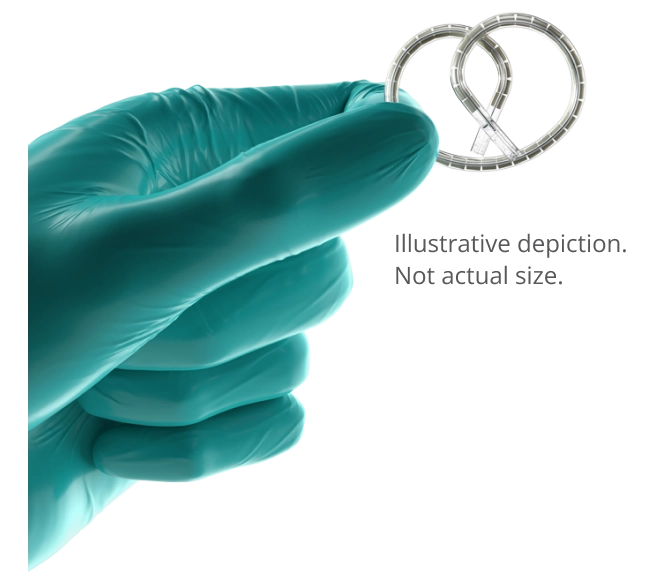STUDY DESIGN1
The efficacy of INLEXZO™ was evaluated in Cohort 2 of SunRISe-1, a single-arm, multi-center study in 83 adults with BCG-unresponsive NMIBC with CIS, with or without papillary tumors (T1 or high-grade Ta) following transurethral resection. The major efficacy outcome measures were complete response (CR) rate at any time and duration of response (DoR).
Powerful
CR RATE1*
(68/83) (95% CI, 72%-90%) CR was achieved
without reinduction4†‡
DURABLE RESPONSE1‡†
(35/68) of patients maintained
a CR ≥12 months(range: 0-44+ months)
PROVEN SAFETY PROFILE1
The two most common ARs were urinary frequency (48%) and urinary tract infection (44%)
of patients had a serious AR
of patients permanently discontinued due to ARs
Dosage interruptions due to ARs occurred in 41% of patients
*CR rate at any time was defined as negative results for cystoscopy (with transurethral resection of bladder tumor [TURBT] and centrally reviewed biopsies as applicable) and centrally reviewed urine cytology.1
†Based on patients (n=68) that achieved a CR at any time. DoR was defined from the time of first CR achieved to first evidence of recurrence, progression, or death due to any cause (whichever was earlier) for participants who achieved a CR.1,5
‡Reinduction was not included in the study design.4
*CR rate at any time was defined as negative results for cystoscopy (with transurethral resection of bladder tumor [TURBT] and centrally reviewed biopsies as applicable) and centrally reviewed urine cytology.1
†Reinduction was not included in the study design.4
‡Based on patients (n=68) that achieved a CR at any time. DoR was defined from the time of first CR achieved to first evidence of recurrence, progression, or death due to any cause (whichever was earlier) for participants who achieved a CR.1,5

Persistent
INLEXZO™ provides prolonged local delivery of gemcitabine into the bladder for weeks, not hours1-3
Of the total gemcitabine dose, 77% was excreted by Day 7 and 99% was excreted by Day 21 in urine as gemcitabine and dFdU1
PRACTICE-CHANGING
Practice-Changing
Off-the-shelf storage with no refrigeration or special preparation1§
Familiar, in-office procedures: catheterization and cystoscopy6
BCG, Bacillus Calmette–Guérin; CIS, carcinoma in situ; dFdU, difluorodeoxyuridine.
§INLEXZO™ does not require freezing, refrigeration, reconstitution, or use of a hood for preparation.1
Watch the Procedural Video
for INLEXZO™
This video explains the preparation, insertion, removal, and disposal of INLEXZO™
Consider choosing INLEXZO™ first after BCG for your appropriate patients with NMIBC
ABOUT INLEXZO™References: 1. INLEXZO™ [Prescribing Information]. Horsham, PA: Janssen Biotech, Inc. 2. Data on file. Janssen Biotech, Inc. 3. Palugan L, Cerea M, Cirilli M, et al. Intravesical drug delivery approaches for improved therapy of urinary bladder diseases. Int J Pharm X. 2021;3:100100. doi:10.1016/j.ijpx.2021.100100 4. Jacob JM, Guerrero-Ramos F, Necchi A, et al. TAR-200 monotherapy in patients with bacillus Calmette–Guérin–unresponsive high-risk non–muscle-invasive bladder cancer carcinoma in situ: 1-year durability and patient-reported outcomes from SunRISe-1. Presented at: 120th American Urological Association Annual Meeting; April 26-29, 2025; Las Vegas, NV. 5. Janssen Research & Development, LLC. Phase 2b clinical study evaluating efficacy and safety of TAR-200 in combination with cetrelimab, TAR-200 alone, or cetrelimab alone in participants with high-risk non-muscle invasive bladder cancer (NMIBC) unresponsive to intravesical Bacillus Calmette-Guerin (BCG) who are ineligible for or elected not to undergo radical cystectomy. October 4, 2024. Accessed September 2, 2025. https://ascopubs.org/doi/suppl/10.1200/JCO-25-01651/suppl_file/protocol1_JCO-25-01651.pdf 6. INLEXZO™ [Instructions for Use]. Horsham, PA: Janssen Biotech, Inc.



